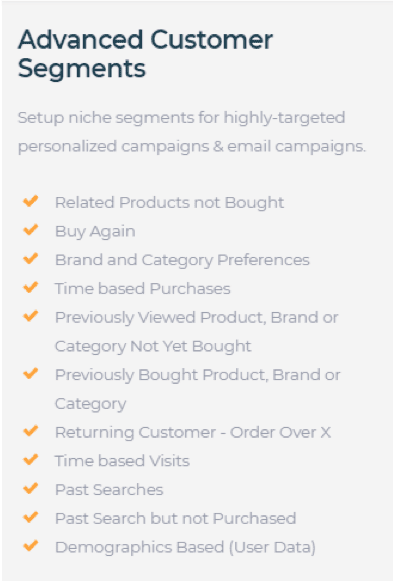14 ways to segment your target audience for effective e-commerce personalization
As defined by Smart Insights, segmentation shows approaches to grouping prospects and customers to deliver more relevant communications and offers. The result is to give better response rates to these communications.

In the marketing arena, personalization is a term often misused for segmentation. Personalization and segmentation, while both valuable tools for marketers, couldn't be more different.
Segmentation and targeting workbook template
Review techniques to increase relevance and response across paid, earned, and owned media with our easy-to-use segmentation and targeting template.
Access the Segmentation and targeting workbook template
The personalization v segmentation debate

Segmentation is grouping customers together according to identifiable characteristics. Often, these are demographic characteristics such as age, geography, gender, favourite brand or AOV.
Personalization is the optimizing of experiences and messages to individuals themselves — not the group they belong to.
The introduction of Artificial Intelligence and Machine Learning algorithms means it’s now possible to predict website visitors’ likes of products, categories and brands based on similar users’ behaviour. Behavioral data from every single website visitor includes views, purchases, searches and even time of day or amount spent. This data is then analyzed and relationships are then identified between different customer segments and the products that businesses sell online.
Key benefits to segmentation
There are five key benefits to having a good customer segmentation when looking to improve your customer's online experience through personalization
- Better match of your product or service offering to your customer's segment needs. Creating tailor-made marketing initiatives
- Improve product or services offered. Businesses can use market segmentation to identify what does work but more importantly what doesn’t work and alter accordingly
- Enable businesses to retain more customers by offering products that appeal to where customers are in their stage of life
- Allow business to grow by upselling on customers who have responded to introductory offers
- Enhance business profits by targeting customers who have a propensity to have more disposable income by raising their average selling price
So where to start with customer segmentation?
E-commerce personalization depends on the data sources your solution can access and personalize against. There are many types of data and segmentation options available in analytics and personalization that you can use customize with.
Below are fourteen of the most relevant segmentation options that can be used for personalization, some of which use anonymous data but others which use existing profile information.
As well as standard segmentation options like those above, you should review solutions from your provider to create and save custom segments. Most established providers should be providing an on top of which you can create your own customized segments.
14 ways to segment your audience

1. Segmentation by referrer or traffic source
This means where the place where your visitor was prior to landing on your website. An AI-based personalization system can learn which offers work best for visitors from different sites, whether referral sites, social media, direct or from paid link ads.
2. Visitor type
For example, new visitors or returning visitors can be identified in analytics and in personalization systems. This is a commonly used technique for personalization, for example, offering new visitors a discount on first purchase or creating welcoming rewards for repeat purchasers.
3. Customer information
Customer segments can be either profile based or behavior based. Behavior-based segments are based on, for example, what users have searched for on current and previous visits or purchase behavior. Profile-based segments are based on what kind of customer they are to the business, for example, VIP, infrequent visitors, first time visitor. This segmentation allows businesses to upsell, cross-sell and incentivize to buy again.
4. Site engagement duration or times
Examples of this are browsing time or number of pages viewed. In some circumstances, it may be best to deliver personalization to visitors who have engaged with the site for a certain length of time. Audience behavior can also vary based on day or week or time of day, so audiences visiting at different times can be targeted differently.
5. Content (products) viewed
This is the most common segmentation technique used in retail personalization, based on product categories or individual products viewed. Related products of a similar style can be shown. Given the large number of products (SKUs) many retailers hold, some form of automation rather than a rules-based system is required here.
6. Landing page
This is a slightly different form of content-based segmentation based on where the visitor first arrived on the site, which suggests their initial intent.
7. Event or interaction
Common interactions on an e-commerce site are people who click on add to basket, cart or interact with product information. This can be selectors for product variants such as color or size or reviews. The value in the cart can also be referenced.
8. Platform and device
As with analytics, a personalization system will usually be able to recognize browser, screen resolution, and device type (smartphone, tablet or larger screen formats). Not only will e-commerce personalization allow up to set up campaigns targeting mobile phone users to test against desktop campaigns, but AI-based systems may learn useful personalization rules, e.g. visitors on Apple iOS or desktop platforms prefer higher-value products. Multi-device tracking is a requirement, including mobile apps where relevant.
9. Location
Such as country, region or city, weather and season.
10. Third-party data sources
Using email addresses, names, and other identifiers, you may be able to enrich customer data about demographics using data from external resources.
11. Favourites & Likes
Based on previous purchases, segment your customers based on their likes and what their tagged favorites are. This can be done at brand, category and at product level.
12. Average Order Value
If a customer’s purchases have exceeded a certain value, then you can cross-sell in other products of similar value which may be of interest to either warrant a discount offer.
13. Current cart profile
If a visitor has put products into their cart, you can promote products that have similar product profiles whether that be color, material, theme, or sizing. The profile attributes you can match are endless.
14. Account type
This is more relevant for B2B customers. This can be segmenting customers based on their pricing tier or the product range that they have made available to them.
View the full guide "E-commerce personalization: The complete Buyer's guide to selecting the best platform" to review examples of personalization used in e-commerce and gain access to a personalization recommendations checklist.
Joanne Burman is the Digital Marketing Manager at
PureClarity and has over the last 12 years worked in the e-commerce and Digital Marketing field across several B2C sectors including retail, healthcare and leisure, helping companies devise clear strategies to grow their online business.
From exploring new technologies to try and create a more tailored online shopping experience through to building customer and brand loyalty she has delivered growth targets in all her roles to date.
Jo, as well as loving her morning coffee, has a strong belief that data has become the new business currency and the more insight companies have into their customer's behaviour the more they can tailor their marketing and eCommerce strategies to enable growth.










